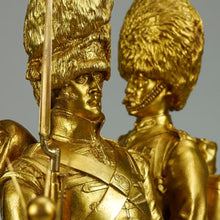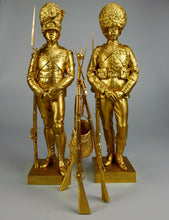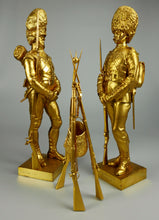A Grenadier Guards Garniture by Elkington & Co, 1888 & 1889
Adding product to your cart
Overall: 58cm (23ins)
Gilt bronze. A garniture comprising two figures of Grenadier Guards by Sir Joseph Edgar Boehm and George Wade, together with a stand of arms ensuite. Boehm's figure cast by Elkington & Co.; the figure by Wade cast by the Belgian bronze art founder H. Luppens & Cie.
Sir Joseph Edgar Boehm, Bt., R.A. (1834-1890) sculpted his Guardsman in the review order uniform of July 1815 with the new addition of the bearskin cap. Following the defeat of Napoleon's Old Guard Grenadiers at the hands of Sir Peregrine Maitland's Guards Brigade at Battle of Waterloo on 18 June 1815, the Prince Regent issued an order awarding the 1st Foot Guards the distinction of adopting the bearskin cap as worn by Napoleon's Old Guard in place of the British Army's regulation pattern shako. The present figure was cast as a reduced scale version of one of the four Warterloo soldiers surrounding Boehm's equestrian statue of the Duke of Wellington at Hyde Park Corner, London which was unveiled by the Prince of Wales in 1888. Each of the flanking figures was conceived as a representation of the rank and file from each of the four home nations of the British Isles that were present at the Allied victory at Waterloo that change the face of Europe for a hundred years. The other three are a Royal Highlander, an Inniskilling Dragoon and a Welsh Fusilier,
Read more
The second figure by George Wade (1853-1933) represents veteran Guardsman of the Anglo-Egyptian War and Sudan Campaigns of the 1880s. Said to be a regimental commission of the late 1880s, it is one of a hundred cast and was paired with Boehm's bronze ( see Guards Museum, Birdcage Walk). Queen Victoria purchased the first of the edition 101 bronzes produced under Wade's direction. The Guardsman is shown in marching order with bearskin cap and regimentally specific valise badge. He is armed with the breech-loading Lee-Metford with bayonet fixed. The chevrons on his lower left sleeve are Good Conduct Badges, each being awarded for five years unblemished service. The four chevrons confirm entitlement to the Army Long Service and Good Conduct medal for eighteen years service worn beside his Egypt and Sudan Medal, 1882-1889, and Khedive's Star 1882.
Sir Edgar Boehm, Bt., RA (1834-1890) was born in Vienna, the son of the Director of the Austrian Imperial Mint. He came to London 1848 to study in British Museum in Italy, Paris, and Vienna, where he won the First Imperial Prize in 1856. In 1862 he settled permanently in London and later the same year first exhibited at Royal Academy. He took British nationality in 1865, and was appointed an ARA in 1878 and an RA. in 1882. He was a Lecturer on sculpture at Royal Academy and received the membership of several foreign academies. Boehm enjoyed a constant flow of commissions for public monuments, portrait statues and busts and became Sculptor in Ordinary to Queen Victoria in 1881. His notable works include Lord Napier of Magdala in Queen's Gate, Kensington; the Prince Imperial (killed in the Zulu War of 1879-80) in St George's Chapel, Windsor; Gordon of Khartoum in St Paul's Cathedral; Thomas Carlyle on Chelsea Embankment; the free standing figures of Queen Victoria and the Prince of Wales on Temple Bar Memorial, Fleet Street; and the portrait head of Queen Victoria for the 1887 coinage. Boehm's royal connections extended beyond his professional abilities as a sculptor. He was rumoured to be the lover of Princess Louise, Queen Victoria's artistic daughter. Moreover it was reported that Princess Louise 'discovered' Sir Edgar's body in his studio off Fulham Road.
George Edward Wade (1853-1933) exhibited at the Royal Academy in 1889 and took over Boehm's studio in 1891. Wade's long and varied career included the production of many well known public works. These included his bronze statue of King Edward VII for Madras, Reading, and Hong Kong. His marble statue of Queen Victoria (1902) in the gardens of the Presidential Residence in Colombo, Sri Lanka, and another for Allahabad, India. A colossal bronze statue of the Duke of Connaught for Hong Kong; Sir William Rose Mansfield, first Baron Sandhurst for Bombay and a Cameron Highlander for Inverness. He executed the impressive 50 foot tall monument to Sir John A Macdonald (1895) which stands beneath its ornate portico at Montreal in Canada. Copies were produced for both Hamilton and Kingston in Canada. For India he produced a portrait statue King George V to coincide with e royal visit of 1911. He produced the monolithic Pietermaritzburg War Memorial in South Africa. He sculpted the equestrian statues of Sir Chandra Shamshere Yung for Nepal and Field Marshal Earl Haig for the esplanade of Edinburgh Castle. In 1929 he sculpted Salvation Army General and Mrs Booth for Champion Park, Denmark Hill, London. He designed a children's fountain for the Women's World Temperance Movement Association, a copy of which stands in Temple Gardens, Embankment, London. His last work was the Stourbridge War Memorial which was inaugurated in 1931. In private life Wade was a keen golfer, designed houses for his friends and tried his hand at airplane design. He died at home at Hyde Park Street in London on 5 February 1933. He married Isabella Mary Josephine, daughter of Lieutenant-General J. M. Macintyre, RA, and they had two daughters.










